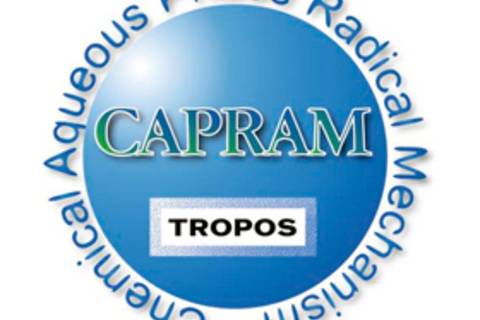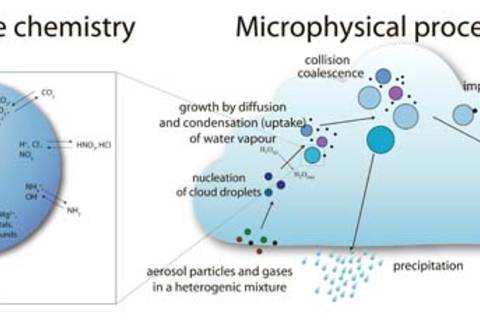Multiphase Modelling
In the research area multiphase chemistry modeling, detailed aqueous phase mechanisms are developed and applied within numerical models studying the physico-chemical multiphase processing in cloud droplets and deliquescent aerosol particles. The main focus of the model applications is given to the analysis of aqueous-phase oxidations und their effect on the tropospheric oxidation capacity and its contribution to the formation of secondary particulate matter. For modelling of the complex tropospheric multiphase system, a spectral air parcel model SPACCIM (SPectral Aerosol Cloud Chemistry Interaction Model; Wolke et al., 2005), which were developed within the modelling department is used. The currently applied multiphase mechanism consists of the gas-phase mechanism MCMv3.2 (mcm.york.ac.uk) and the aqueous phase mechanism CAPRAM4.0 (Chemical Aqueous Phase Radical Mechanism, Bräuer et al., 2019). The phase transfer of soluble species is treated in the model according to the approach by Schwartz (1986).
Within the aqueous-phase chemistry mechanism, particular emphasis was given to chemical processes of organic compounds and radicals such as NO3, OH, SO4-, Cl2-, Br2-, CO3- as well as peroxy radicals. In contrast to other existing aqueous-phase mechanisms, CAPRAM 4.0 also includes reactions of organic compounds with up to 4 carbon atoms (alcohols, carbonyls, carboxylic acids) besides the common C1-C2 chemistry. In the mechanism, a detailed reaction scheme concerning sulfur(IV) oxidation by radicals, transitional metal ions (iron, copper and manganese), peroxides and ozone is included.
In addition to the basic mechanism of CAPRAM, reduced chemical mechanisms (Deguillaume et al., 2009, Hoffmann et al., 2020) for regional scale chemistry transport models and further mechanism modules were developed throughout the last years. Additional reaction modules such as the Halogen module 1.0/2.0/3.0 (Herrmann et al., 2003; Bräuer et al., 2013, Hoffmann et al., 2019) contains radical reactions of halogen containing species in both phases and can be applied for the modelling of the multiphase chemistry in the marine boundary layer. Furthermore, a module was developed which describes the oxidation of DMS in tropospheric multiphase chemistry (CAPRAM-DM1.0, Hoffmann et al., 2016) as well as a module describing the oxidation of substituted aromatic compounds in the tropospheric aqueous phase (CAPRAM-AM1.0, Hoffmann et al., 2018). Moreover, a mechanism module describing the multiphase chemistry of amines was developed. More recently, the mechanism generator GECKO-A (Aumont et al., 2005 ) was extended to the aqueous phase enabling that the organic chemistry in CAPRAM can automatically be generated according to a predefined mechanism protocol (Bräuer et al., 2019). The extended GECKO-A is based on an aqueous-phase kinetic database of measured kinetic constants, evaluated structure-activity relationships and other correlations for the mechanism construction. Further information, corresponding references as well as all available mechanisms and reaction modules can be found at the CAPRAM - website for usage. In addition, the latest comments and corrections are available.
References:
Bräuer, P., A. Tilgner, R. Wolke, and H. Herrmann (2013), Mechanism development and modelling of tropospheric multiphase halogen chemistry: The CAPRAM Halogen Module 2.0 (HM2), J Atmos Chem, 19-25. dx.doi.org/10.1007/s10874-013-9249-6
Bräuer, P., Mouchel-Vallon, C., Tilgner, A., Mutzel, A., Böge, O., Rodigast, M., Poulain, L., van Pinxteren, D., Wolke, R., Aumont, B., and Herrmann, H. (2019): Development of a protocol for the auto-generation of explicit aqueous-phase oxidation schemes of organic compounds, Atmos Chem Phys, 19, 9209–9239, doi.org/10.5194/acp-19-9209-2019, 2019.
Deguillaume, L., A. Tilgner, R. Schrödner, R. Wolke, N. Chaumerliac, and H. Herrmann (2009), Towards an operational aqueous phase chemistry mechanism for regional chemistry-transport models: CAPRAM-RED and its application to the COSMO-MUSCAT model, J Atmos Chem, 64(1), 1-35. http://dx.doi.org/10.1007/s10874-010-9168-8
Ervens, B., C. George, J. E. Williams, G. V. Buxton, G. A. Salmon, M. Bydder, F. Wilkinson, F. Dentener, P. Mirabel, R. Wolke, H. Herrmann (2003), CAPRAM 2.4 (MODAC mechanism): An extended and condensed tropospheric aqueous phase mechanism and its application, Journal of Geophys Res-Atmos, 108(D14), -. http://www.dx.doi.org/10.1029/2002JD002202
Herrmann, H., A. Tilgner, P. Barzaghi, Z. Majdik, S. Gligorovski, L. Poulain, and A. Monod (2005), Towards a more detailed description of tropospheric aqueous phase organic chemistry: CAPRAM 3.0, Atmos Environ, 39(23-24), 4351-4363. dx.doi.org/10.1016/j.atmosenv.2005.02.016
Herrmann, H., B. Ervens, H. W. Jacobi, R. Wolke, P. Nowacki, and R. Zellner (2000), CAPRAM2.3: A chemical aqueous phase radical mechanism for tropospheric chemistry, Journal of Atmospheric Chemistry, 36(3), 231-284. doi.org/10.1023/A:1006318622743
Herrmann, H.; Majdik, Z.; Ervens, B. and Weise D. (2003), Halogen production from aqueous tropospheric particles, Chemosphere 52, 485-502. doi.org/10.1016/s0045-6535(03)00202-9
Hoffmann, D., A. Tilgner, Y. Iinuma, and H. Herrmann (2010), Atmospheric Stability of Levoglucosan: A Detailed Laboratory and Modeling Study, Environ Sci Technol, 44(2), 694-699. dx.doi.org/10.1021/es902476f
Hoffmann, E. H.; Tilgner, A.; Wolke, R.; Böge, O.; Walter, A. and Herrmann, H. (2018), Oxidation of substituted aromatic hydrocarbons in the tropospheric aqueous phase: kinetic mechanism development and modelling, Phys Chem Chem Phys 20, 10960. doi.org/10.1039/C7CP08576A
Hoffmann, E. H.; Tilgner, A.; Schrödner, R.; Bräuer, P.; Wolke, R. and Herrmann, H. (2016), An advanced modeling study on the impacts and atmospheric implications of multiphase dimethyl sulfide chemistry, Proc Natl Acad Sci USA 113, 11776-11781. https://doi.org/10.1073/pnas.1606320113
Hoffmann, E. H., Tilgner, A., Wolke, R., Herrmann, H. (2019) Enhanced chlorine and bromine atom activation by hydrolysis of halogen nitrates from marine aerosols at polluted coastal areas, Environ Sci Technol, 53, 771-778, https://doi.org/10.1021/acs.est.8b05165.
Hoffmann, E. H., Schrödner, R., Tilgner, A., Wolke, R., Herrmann, H. (2020) CAPRAM reduction towards an operational multiphase halogen and dimethyl sulfide chemistry treatment in the chemistry transport model COSMO-MUSCAT(5.04e), Geosci Model Develop, 13, 2587-2609, doi.org/10.5194/gmd-13-2587-2020.
Schwartz, S. E. (1986), Mass-transport considerations pertinent to aqueous phase reactions of gases in liquid-water clouds Rep. NATO ASI Series Vol. G6, NATO. Tilgner, A., P. Bräuer, R. Wolke, and H. Herrmann (2013), Modelling multiphase chemistry in deliquescent aerosols and clouds using CAPRAM3.0i, J Atmos Chem, 70(3), 221-256.
Tilgner, A., and H. Herrmann (2010), Radical-driven carbonyl-to-acid conversion and acid degradation in tropospheric aqueous systems studied by CAPRAM, Atmos Environ, 44, 5415-5422. http://dx.doi.org/10.1016/j.atmosenv.2010.07.050
Tilgner, A., Z. Majdik, A. M. Sehili, M. Simmel, R. Wolke, and H. Herrmann (2005), SPACCIM: Simulations of the multiphase chemistry occurring in the FEBUKO hill cap cloud experiments, Atmos Environ, 39(23-24), 4389-4401. dx.doi.org/10.1016/j.atmosenv.2005.02.028


